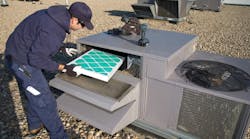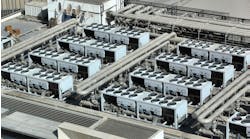There is still much we don’t know about HVAC and COVID-19 transmission, but HVAC best practices may reduce the risk of transmission somewhat, according to two statements by ASHRAE.
ASHRAE’s statement on the airborne transmission of SARS-CoV-2, the virus that causes COVID-19, concluded, “Transmission of SARS-CoV-2 through the air is sufficiently likely that airborne exposure to the virus should be controlled. Changes to building operations, including the operation of heating, ventilating and air-conditioning systems, can reduce airborne exposures.”
The organization also released an HVAC-specific statement: “Ventilation and filtration provided by heating, ventilating and air-conditioning systems can reduce the airborne concentration of SARS-CoV-2 and thus the risk of transmission through the air. Unconditioned spaces can cause thermal stress to people that may be directly life-threatening and that may also lower resistance to infection. In general, disabling of heating, ventilating and air-conditioning systems is not a recommended measure to reduce the transmission of the virus.”
ASHRAE explains in a recent position document on infectious aerosols that there are three ways an HVAC system can help mitigate airborne pathogens: filtration, disinfection or ventilation. Your ideal strategy depends on your individual building and HVAC system, but the three strategies will likely overlap.
“There’s not a one size fits all solution,” explains Robert LoForte, president of Veritas Solutions Group, a smart building infrastructure service and solution provider. “Each facility needs to develop its own plan that factors in how the space may be used, the systems they have and budgetary constraints.”
Here are some key facts to know about the filtration part of the equation and how to apply it to your facility.
Air Filtration Basics
To be effective against any airborne disease, air filters have to meet three conditions, according to Dr. Jeffrey Siegel, a professor in the Department of Civil and Mineral Engineering at the University of Toronto.
1. Droplets or particles containing the disease have to move through the filter. This mostly depends on airflow, Siegel says.
2. The filter has to remove the virus from the air. “Usually we think about that in terms of filter efficiency,” Siegel explains.
3. The filter has to make a difference in the concentration of the virus. “If you had a very leaky building with an open window, the filter isn’t going to make much of a difference because there’s already a large amount of loss containing virus particles through the open windows,” Siegel explains. “The filter has to be important to the overall movement of the virus.”
There are two key issues with these seemingly simple requirements, Siegel adds. “One is that the virus doesn’t present itself to the filter at one size. It will be in a bigger droplet or a particle that contains some dust, a droplet and the virus,” Siegel says. “There’s not one size we’re targeting. That makes it difficult to talk about filter efficiency because we’re talking about a bunch of different sizes.”
The other is that filter efficiency is determined by testing the filters in a laboratory, but the way filters perform in a lab aren’t necessarily the same as how they perform in a building.
“Everyone who’s ever changed a filter knows the filter doesn’t fit perfectly. There are usually gaps around it. We call that filter bypass and it’s really important,” Siegel says. “If it’s not installed well, a lot of the air can be going around the filter instead of through it.”
With that said, Siegel recommends a filter with an efficiency rating of at least MERV 13. However, he cautions against simply buying the most efficient filter you can buy, because the higher the MERV rating, the more pressure drop you’ll have to deal with. In other words, your HVAC system will have to push harder to get air through the filter, which means more air will bypass the filter wherever it can find a gap to flow through.
[Related: COVID-19: Have You Kept Up with Pest Control?]
Portable Air Filters
No air filter can be a silver bullet where COVID-19 is concerned, but there may be some benefits to installing portable air filtration units, especially for targeted areas where extra filtration is needed because of occupancy or close contact, LoForte says.
However, to be effective, they need to be sized appropriately for the room they’re in – you can’t put a small unit in a large open office and expect it to protect everyone.
“Take the square footage of the room and multiply it by the ceiling height. That’s the volume of air you have,” LoForte explains. “To be effective, you need to circulate that air a certain number of times per hour. If you have a 4,000-square-foot lobby with 20-foot ceilings and put one small portable unit in there, it’s probably not going to be effective.”
Adds Siegel, “You have to be able to interrupt the transition [of air] from Person A to Person B and that depends on airflow, the device and how well it works, and how it affects the airflow. It’s not going to hurt, but how much it helps varies a lot based on the context, just like with ordinary filtration. You’ve got to get the air to the filter and the filter’s got to remove it. It also has to compete with other things going on, so if you have a super high ventilation rate and a little portable filter, it’s not going to help that much.”
Keeping Your Staff Safe
There are so many unknowns with COVID-19 that extra protection is warranted when you’re changing the filters in your HVAC system, LoForte says. Wear an N95 respirator, eye protection and gloves when you handle the filter.
Before disposal, filters can be disinfected with a bleach solution and then sealed in a bag once it’s removed from your HVAC system, LoForte adds. It’s important to reduce your risk whenever you can, especially with a new virus that we don’t fully understand yet.
The jury is still out on how much of an impact HVAC makes on COVID transmission, but as ASHRAE notes, it’s likely that HVAC has a risk reduction role to play when it comes to COVID. That likelihood is great enough that facilities professionals should look to improve air filtration and HVAC operation wherever possible.
“This is an opportunity for building operators to look at their HVAC and filtration systems and make improvements,” Siegel says. “The worst possible consequence is that you improve ventilation and filtration in your building. Your worst possible outcome is that your occupants are healthier and more productive, and the best possible outcome is that we reduce COVID-19 transmission risk. Let’s put some effort and resources into these parts of the building.”
Read Next: Why HVAC Maintenance is Important Year-Round



